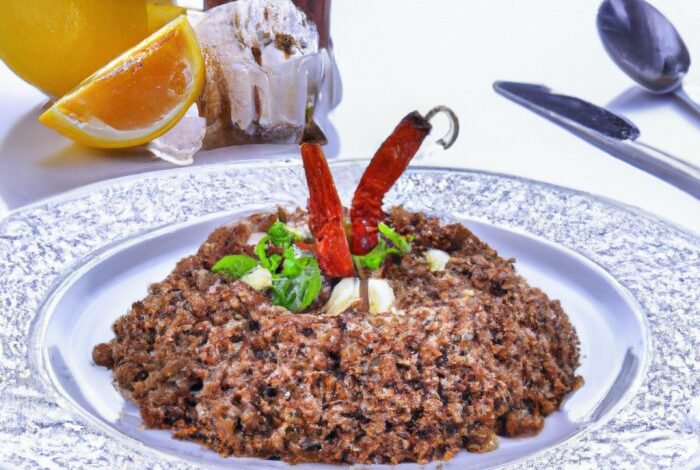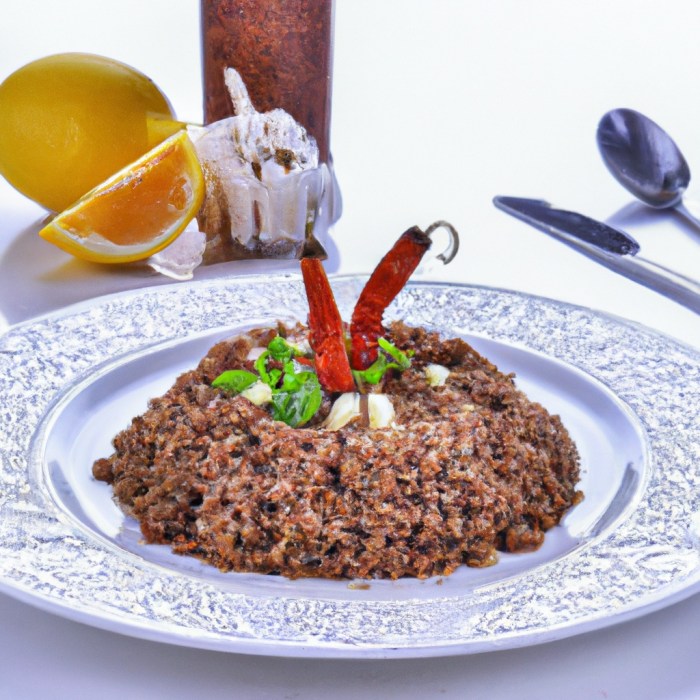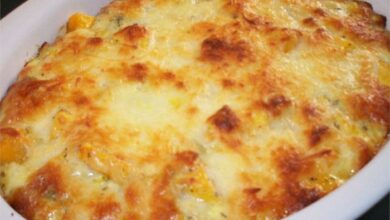
Mujaddara Arabic Lentil Rice: A Culinary Journey Through History
Mujaddara Arabic lentil rice, a humble yet flavorful dish, holds a rich history that spans continents and cultures. This comforting blend of lentils, rice, and caramelized onions has been a staple in the Middle East and beyond for centuries, its origins tracing back to ancient civilizations.
The dish’s simplicity belies its complex and fascinating story, a story that weaves together culinary traditions, cultural significance, and the enduring power of food to connect people across time and space.
From its roots in ancient Mesopotamia to its modern-day interpretations, mujaddara has evolved alongside the people who cherish it. Its recipe has been adapted and passed down through generations, each variation reflecting the unique flavors and ingredients of its region.
This dish isn’t just a meal; it’s a testament to the resilience of culinary traditions and the enduring power of food to bring people together.
Origins and History of Mujaddara
Mujaddara, a humble yet flavorful dish of lentils and rice, holds a rich history that spans across cultures and continents. Its origins can be traced back to ancient times, with variations found in various regions, each reflecting the culinary traditions and influences of its people.
Origins and Evolution of Mujaddara
Mujaddara’s roots lie deep in the Middle East, where it is believed to have originated in ancient Mesopotamia, the cradle of civilization. The dish’s name itself is derived from the Arabic word “mujadar,” which means “to be mixed,” aptly describing the simple yet satisfying combination of lentils and rice.
Ancient Mesopotamian civilizations, known for their agricultural prowess, likely incorporated lentils and rice into their diets, leading to the evolution of mujaddara.
Variations of Mujaddara Across Regions
Mujaddara has undergone various transformations and adaptations over time, resulting in diverse regional variations.
- In the Levant, mujaddara is often prepared with caramelized onions, adding a sweet and savory dimension to the dish.
- In Egypt, mujaddara is known as “mujadara bel koushari,” featuring a blend of rice, lentils, macaroni, and chickpeas, creating a hearty and flavorful meal.
- In Iran, mujaddara is often seasoned with turmeric, saffron, and cinnamon, lending a distinct aroma and flavor profile.
Anecdotes and Stories Related to Mujaddara’s History
Mujaddara has become a staple in many Middle Eastern and Mediterranean households, its simple ingredients and comforting flavors making it a beloved dish. Its history is interwoven with cultural traditions and stories, adding to its allure.
“Mujaddara is said to be a dish enjoyed by the poor and the rich alike, its simplicity and affordability making it accessible to all.”
The dish is often associated with themes of humility and contentment, reminding people to appreciate the simple things in life. Mujaddara’s enduring popularity is a testament to its cultural significance and its ability to connect people across generations.
Ingredients and Preparation
Mujaddara, with its simple ingredients and satisfyingly comforting flavors, is a testament to the beauty of culinary simplicity. The key to achieving the perfect mujaddara lies in understanding the individual components and how they come together harmoniously.
Ingredients
The classic mujaddara recipe calls for a handful of readily available ingredients.
- Rice:Long-grain white rice is the preferred choice for mujaddara, as it holds its shape well after cooking and provides a fluffy texture.
- Lentils:Brown lentils are the standard choice for mujaddara. They cook quickly and absorb the flavors of the other ingredients beautifully.
- Onions:Onions are the star of the show in mujaddara, adding a sweet and savory depth of flavor.
- Olive Oil:High-quality olive oil is essential for frying the onions and adding a rich, fruity aroma to the dish.
- Salt:Salt enhances the flavors of the ingredients and balances the sweetness of the onions.
- Black Pepper:A touch of black pepper adds a subtle warmth and complexity to the dish.
- Optional Ingredients:While not essential, some cooks like to add cumin, cinnamon, or other spices for a more complex flavor profile.
Preparing the Ingredients
Each ingredient plays a crucial role in creating the final dish, so proper preparation is essential.
- Rice:Rinse the rice thoroughly under cold water until the water runs clear. This removes excess starch, preventing the rice from becoming sticky. Soak the rice in fresh water for 30 minutes, then drain. This helps the rice cook evenly and absorb the flavors more effectively.
- Lentils:Pick over the lentils, removing any debris or damaged lentils. Rinse them thoroughly under cold water.
- Onions:Thinly slice the onions, ensuring they are roughly the same size for even cooking.
Cooking Mujaddara
The process of cooking mujaddara is straightforward and yields a satisfyingly comforting dish.
- Fry the Onions:Heat the olive oil in a large pot over medium heat. Add the sliced onions and cook, stirring occasionally, until they are softened and golden brown. This caramelization process is key to developing the rich flavor of the onions.
- Cook the Lentils:Add the rinsed lentils to the pot with the onions. Pour in enough water to cover the lentils by about an inch. Bring the mixture to a boil, then reduce heat to low, cover the pot, and simmer for about 20-30 minutes, or until the lentils are tender.
- Add the Rice:Stir in the rice and add more water if necessary to cover the rice and lentils by about an inch. Bring the mixture back to a boil, then reduce heat to low, cover the pot, and simmer for about 15-20 minutes, or until the rice is cooked through and the water has been absorbed.
- Season and Serve:Season the mujaddara with salt and black pepper to taste. Let it rest for 5-10 minutes before serving. Garnish with a drizzle of olive oil and a sprinkle of chopped parsley, if desired.
Cultural Significance and Variations

Mujaddara, a humble dish of lentils and rice, holds a significant place in the culinary traditions of many cultures across the Middle East and beyond. Its simple ingredients and comforting flavors have made it a staple food for generations, carrying with it a rich tapestry of cultural significance and variations.
Cultural Significance
Mujaddara is more than just a meal; it is a symbol of comfort, sustenance, and tradition. In many cultures, it is associated with religious holidays and special occasions, representing abundance and blessings.
- In Lebanon, mujaddara is often served during Ramadan, the Muslim holy month of fasting, as a nourishing and satisfying meal after sunset.
- In Syria, it is a popular dish for Eid al-Adha, the Muslim festival of sacrifice, symbolizing the sharing of blessings and the importance of community.
- In Palestine, mujaddara is a cherished comfort food, often prepared by mothers and grandmothers, passed down through generations, representing family and tradition.
Regional Variations
While the basic ingredients of mujaddara remain consistent, regional variations add unique flavors and textures to the dish.
- In Egypt, mujaddara is often flavored with cumin and turmeric, giving it a warm and earthy aroma.
- In Turkey, the dish is typically cooked with bulgur wheatinstead of rice, resulting in a chewier texture.
- In Iran, mujaddara is sometimes enriched with dried fruitslike raisins or apricots, adding sweetness and a touch of luxury.
- In India, mujaddara is known as moong dal khichdiand is often seasoned with ginger, garlic, and chili peppers, adding a spicy kick.
Symbolism and Cultural Meaning, Mujaddara arabic lentil rice
The symbolism of mujaddara extends beyond its culinary significance. The combination of lentils and rice, representing both the earth and the sky, is often seen as a symbol of balance and harmony.
Mujaddara, with its comforting blend of lentils and rice, always reminds me of home. It’s a dish that’s simple to make but so satisfying. Sometimes, I like to pair it with something richer, like a slow cooked red braised pork belly , which adds a touch of indulgence to the meal.
But even on its own, mujaddara is a perfect example of how a humble dish can be so flavorful and comforting.
“The lentils symbolize the earth, while the rice represents the sky, creating a harmonious balance in the dish.”
The dark lentils, representing the night, and the white rice, representing the day, are also interpreted as a reminder of the cyclical nature of life. In some cultures, the dish is believed to bring good luck and prosperity.
Nutritional Value and Health Benefits
Mujaddara, a humble dish of lentils and rice, offers a surprising array of nutrients and health benefits. Its simple ingredients pack a powerful punch, making it a nutritious and satisfying meal.
Mujaddara, with its comforting blend of lentils, rice, and caramelized onions, is a dish that reminds me of warm evenings and family gatherings. While mujaddara is a staple in Arabic cuisine, it’s interesting to think about how other cultures approach rice dishes, like the delightful onigiri japanese rice balls , which offer a completely different flavor profile.
But no matter the style, there’s something undeniably satisfying about a simple, well-cooked rice dish – it’s the foundation for so many culinary adventures.
Nutritional Content
Mujaddara is a nutritional powerhouse, boasting an impressive profile of essential vitamins, minerals, and fiber. The lentils provide a rich source of protein, fiber, iron, folate, and magnesium. Rice, on the other hand, contributes carbohydrates for energy, along with B vitamins and manganese.
Mujaddara, with its earthy lentils and fluffy rice, is a comforting dish that always hits the spot. It’s the kind of meal that pairs perfectly with something bright and flavorful, like a juicy grilled salmon. For a truly delicious combination, I highly recommend trying it with Anne’s fabulous grilled salmon , which adds a touch of elegance and a burst of flavor.
After all, a simple dish like mujaddara deserves a little something special to elevate it.
The combination of these ingredients creates a balanced and complete meal.
- Protein:Lentils are an excellent source of plant-based protein, providing about 18 grams per cooked cup. Protein is essential for building and repairing tissues, maintaining healthy bones, and supporting immune function.
- Fiber:Both lentils and rice are good sources of dietary fiber, which promotes digestive health, helps regulate blood sugar levels, and supports a feeling of fullness.
- Iron:Lentils are particularly rich in iron, an essential mineral for carrying oxygen throughout the body. Iron deficiency can lead to fatigue, weakness, and shortness of breath.
- Folate:Folate is crucial for cell growth and development, particularly during pregnancy. Lentils are a good source of this essential vitamin.
- Magnesium:Magnesium is involved in over 300 bodily processes, including muscle function, nerve transmission, and blood sugar regulation. Lentils are a good source of this important mineral.
Health Benefits
The nutritional content of mujaddara translates into a range of health benefits. The high fiber content aids digestion, promotes gut health, and helps regulate blood sugar levels. The protein and complex carbohydrates provide sustained energy, keeping you feeling full and satisfied for longer.
The iron content supports red blood cell production, preventing iron deficiency anemia.
- Improved Digestive Health:The high fiber content in mujaddara promotes regular bowel movements and supports a healthy gut microbiome.
- Blood Sugar Regulation:The fiber in mujaddara slows down the absorption of sugar into the bloodstream, helping to stabilize blood sugar levels and prevent spikes and crashes.
- Heart Health:The soluble fiber in lentils can help lower cholesterol levels, reducing the risk of heart disease.
- Weight Management:The combination of protein and fiber in mujaddara promotes a feeling of fullness, which can help with weight management.
Incorporation into a Healthy Diet
Mujaddara can easily be incorporated into a healthy diet as a main course, side dish, or salad topping. It can be enjoyed hot or cold, and its versatility allows for a variety of flavor combinations.
- Main Course:Serve mujaddara as a hearty and satisfying main course, accompanied by a salad or roasted vegetables.
- Side Dish:Mujaddara can be served as a flavorful side dish alongside grilled chicken, fish, or tofu.
- Salad Topping:Add a scoop of mujaddara to your favorite salad for extra protein, fiber, and flavor.
Serving and Presentation
Mujaddara, a humble yet flavorful dish, is often served in various ways, reflecting the diverse culinary traditions of the Middle East and beyond. The presentation of this dish is just as important as its taste, as it can elevate the dining experience and showcase the cultural significance of this beloved staple.
Traditional Serving Methods
The traditional method of serving mujaddara often involves a simple yet elegant presentation. It is typically served in a large communal dish, allowing everyone to partake and share the meal. In some cultures, it is customary to serve it alongside other dishes, such as salads, dips, or grilled meats, creating a balanced and flavorful spread.
- In Lebanon, mujaddara is often served alongside a mezze platter, featuring a variety of dips, salads, and small plates, allowing guests to enjoy a variety of flavors and textures.
- In Syria, mujaddara is frequently served with grilled kebabs, adding a smoky and savory element to the dish.
- In Palestine, mujaddara is often served with a side of pickled vegetables, providing a tangy contrast to the rich and savory flavors of the dish.
Garnishes and Toppings
While mujaddara is delicious on its own, adding garnishes and toppings can enhance its flavor and visual appeal. These additions can range from simple herbs to more elaborate combinations, depending on personal preference and cultural influences.
- Fresh herbs, such as parsley, mint, and cilantro, are commonly used to add a burst of freshness and aroma to the dish. These herbs can be sprinkled over the mujaddara or arranged on top for a visually appealing presentation.
- A drizzle of olive oil adds richness and depth of flavor, enhancing the overall taste and texture of the dish. The oil also helps to create a glossy sheen, making the mujaddara look more appealing.
- A sprinkle of toasted pine nuts or almonds adds a crunchy texture and nutty flavor to the dish. These nuts can be sprinkled over the mujaddara or arranged on top in a decorative pattern.
- A dollop of yogurt or sour cream provides a creamy and tangy contrast to the savory flavors of the dish. This topping can be added directly to the mujaddara or served on the side for individual preference.
- A sprinkle of sumac adds a tangy and slightly tart flavor to the dish. It can be used to garnish the mujaddara or mixed into the rice and lentils during cooking.
Visual Presentation
Presenting mujaddara in an appealing manner can enhance the dining experience and make it more visually appealing. This can be achieved through various techniques, such as using decorative bowls, garnishes, and plating styles.
“A well-presented dish is a feast for the eyes as well as the palate.”
- Using a decorative bowl or platter can elevate the presentation of mujaddara. Choose a bowl that complements the color and texture of the dish, such as a rustic earthenware bowl or a sleek ceramic plate.
- Arrange the mujaddara in a visually appealing manner. For example, you can create a mound in the center of the bowl and decorate the sides with garnishes, such as fresh herbs, toasted nuts, or a drizzle of olive oil.
- Add a touch of color and texture by using garnishes that complement the flavors of the dish. For example, you can sprinkle fresh parsley, mint, or cilantro over the mujaddara, or arrange a few sprigs of fresh rosemary or thyme around the edges of the bowl.
- Consider the overall presentation of the meal when serving mujaddara. If you are serving it alongside other dishes, make sure the colors and textures complement each other.
Mujaddara in Modern Cuisine: Mujaddara Arabic Lentil Rice
Mujaddara, a humble dish with roots in the Middle East, is experiencing a renaissance in contemporary kitchens. Chefs and home cooks alike are reinterpreting this classic comfort food, infusing it with new flavors, textures, and techniques. The result is a vibrant and evolving culinary landscape where mujaddara transcends its traditional form and embraces innovative interpretations.
Modern Variations of Mujaddara
Modern chefs are pushing the boundaries of mujaddara by incorporating unexpected ingredients and techniques. This creative approach not only elevates the dish but also reflects the diverse culinary influences that are shaping contemporary cuisine.
“Mujaddara is a canvas for creativity,” says Chef [Chef’s name], a renowned culinary innovator. “It allows us to explore different flavor profiles and textures, while still respecting its traditional essence.”
- Elevated Textures: Some chefs are experimenting with different grains and legumes, such as quinoa, black lentils, or barley, to add textural complexity and nutritional value. Others are incorporating roasted vegetables, like eggplant or zucchini, to introduce contrasting textures and flavors.
- Global Flavor Influences: Modern mujaddara often draws inspiration from global cuisines. For example, a chef might add a touch of Moroccan spice blend or a hint of Indian curry powder to create a more complex and nuanced flavor profile.
- Creative Presentation: The presentation of mujaddara is also undergoing a transformation. Chefs are using plating techniques and garnishes to create visually appealing and Instagram-worthy dishes. Some examples include serving mujaddara in individual ramekins, topped with a dollop of yogurt or a sprinkle of toasted nuts.
Restaurants Reimagining Mujaddara
A growing number of restaurants are showcasing innovative mujaddara dishes on their menus. These restaurants are often located in major cities around the world, reflecting the global popularity of this versatile dish.
- [Restaurant name]in [City] is known for its modern interpretation of mujaddara, featuring a blend of black lentils, quinoa, and roasted vegetables, topped with a tangy yogurt sauce.
- [Restaurant name]in [City] offers a unique twist on mujaddara by incorporating smoked eggplant and caramelized onions, creating a smoky and sweet flavor profile.
- [Restaurant name]in [City] presents mujaddara as a deconstructed dish, with each element, such as the lentils, rice, and caramelized onions, served separately, allowing diners to customize their own experience.






